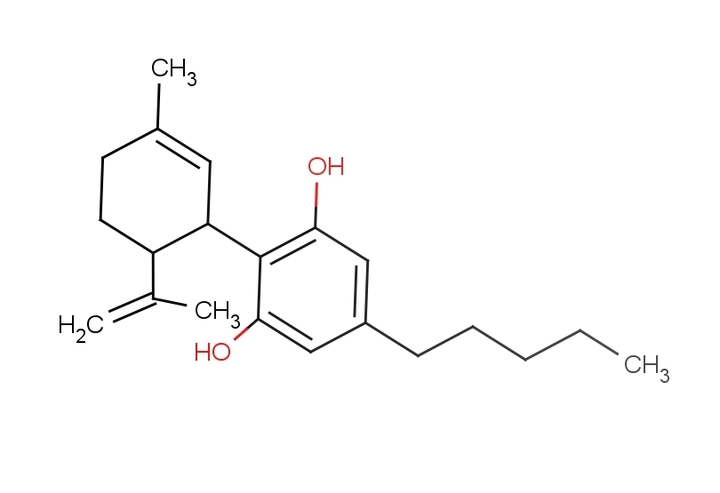The purpose of this article is only informative. We are not qualified to give medical advice and we do not claim in any case that our CBD products have beneficial effects on health.
CBD is a cannabinoid, a chemical substance produced by the cannabis plant. It is the second most common cannabinoid in Cannabis sativa and indica, along with its cousin THC.
What makes CBD so interesting is its high therapeutic potential without psychoactive effects like THC. Here are some important facts about the history of CBD:
1940: CBD has been studied since the 18th century and was first isolated in 1940 by American chemist Roger Adams and his team.
1963: It took more than twenty years for an Israeli chemist named Raphael Mechoulam to show interest in Cannabidiol again. He eventually discovered the entire structure and even synthesized it for the first time, along with THC. These discoveries paved the way for pharmaceutical research on CBD.
1970: This marked the beginning of the first therapeutic investigations into CBD. A group of Brazilian researchers first discovered in 1973 that CBD reduced or even blocked seizures in some animals. Another team discovered a year later that cannabidiol could also help with anxiety. Later clinical studies showed that CBD could combat nausea in chemotherapy patients or help with insomnia.
1980-1990: Discoveries continued: Professor Raphael Mechoulam and a team of scientists from Sao Paulo proved that CBD can actually reduce seizures in epilepsy patients. Another team showed that it has antipsychotic effects. In 1988, the endocannabinoid system was discovered, which brought CBD into serious consideration and paved the way for its medical possibilities. Later, it was considered that CBD could be used for neurodegenerative diseases such as Alzheimer's or Parkinson's due to its antioxidant and neuroprotective effects. In the late 1990s, a significant event occurred in the history of CBD: Three US states, namely Oregon, Alaska, and Washington, officially legalized medical cannabis. In addition, a first license was granted for Sativex to develop a CBD-based medication to relieve pain from people with multiple sclerosis.
2000s: Scientific research continued and made further positive impacts of CBD clear for patients with schizophrenia, cardiovascular disease, or cancer. Studies flourished, and more and more actors in the CBD industry appeared to give this flower its nobility back.

The Effects of CBD
There are two main types of hemp: Sativa (cultivated cannabis) and Indica (Indian cannabis), which contains more cannabidiol. Since it does not develop dominant (psychological) side effects, CBD is not considered a psychotropic drug unlike THC. There are many differences between the two types (geographic origin, appearance, size, flowering time, yield, aromas), but the difference in effects is the one that interests us the most here. Sativa generally has a higher THC/cannabidiol content and is therefore more effective in increasing brain activity, while Indica is more relaxing and affects our mood and stress.
Most studies on the effects of CBD and other cannabinoids are still ongoing, which still means a mystery around cannabis, its effects, and use. However, based on the analysis of cannabidiol by Addiction Suisse, we can see that effects such as reducing spasms in multiple sclerosis and seizures in certain forms of epilepsy are mentioned. Likewise, the analysis based on our current knowledge shows that CBD can contribute to pain and anxiety reduction. It should also be noted that as long as further research results on CBD are not available, it remains difficult to confirm or refute certain effects attributed to it.
This analysis also highlights the positive opinion of CBD consumers about this product: "Current users rate the effects of CBD positively, especially in terms of sleep, stress, and overall well-being." The opinions of the surveyed consumers also remain positive regarding anti-inflammatory, pain-relieving, and anti-depressive and -anxiety effects, which corresponds to an American study on the effects of CBD. Another aspect that emerges from this analysis is the significant to moderate reduction in tobacco and illegal cannabis consumption by CBD consumers, although it is not yet known whether it is a substitution effect or a general reduction in consumption.
The Endocannabinoid System
Studies have shown that CBD affects the endocannabinoid system, which is present in all vertebrates, mammals, birds, and many other animals. This system plays a particularly important role in maintaining and promoting our health, as its receptors can be found throughout the body, from the brain and organs to immune cells. So far, two receptors of the endocannabinoid system have been discovered: CB1 and CB2 (see figure in the source). CB1 is mainly found in the head, brain, cerebral cortex, and neurons, but also in the lungs, heart, digestive system, urinary system, reproductive organs, skin, bones, etc. On the other hand, CB2 is primarily found in immune cells such as leukocytes, mast cells, lymph nodes, tonsils, spleen, and thymus. This receptor has been less studied than CB1, as it does not possess psychotropic effects.
Summary
In summary, hemp growers have focused on achieving a stronger psychoactive effect for years, overlooking the beneficial effects of CBD. As a result, most CBD strains had a content of less than one percent. Since 2011, CBD with a THC content of less than one percent has been fully legal in Switzerland. However, the other potential effects of CBD are still not clearly understood. As mentioned in the analysis of the situation of cannabidiol, our knowledge in this area is still limited, largely due to the almost 50-year ban on CBD. Therefore, we need to be patient and observe the results of ongoing studies.
For more information, you can consult the following site :
Traveling in little known land (Le Nouvelliste)
Source : www.hanf-magazin.com
